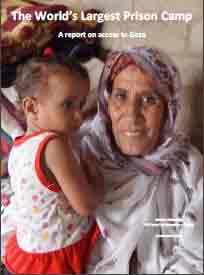The world's largest prison camp
.
A report on access to Gaza
On 20th June Israel announced it was easing the blockade of Gaza, after three years of severely restricting access for food, fuel, construction materials and medical supplies. In October a delegation from the Britain Palestine All Party Parliamentary Group visited Gaza to assess the situation in what Prime Minister David Cameron terms “a prison camp”. Its report has now been published.
Executive Summary
Following the attack upon the Mavi Marmara and the international aid flotilla in May 2010, Israel announced it was easing the blockade of Gaza. Whilst most food items are now permitted to enter the territory (the majority of which were previously banned), the quantity of imports remains deficient. During the visit of the delegation the total number of truckloads entering Gaza represented just 32% of the weekly pre-blockade levels. Construction materials and fuel remain barred for private use and exports are still prohibited.
Only since June 2010, 18 months after Operation Cast Lead, have the UN and internationally funded projects been permitted to import very limited amounts of concrete, steel and glass. On 14th September UNRWA received approval to bring in materials for 13 projects, representing just 1.7% of UNRWA’s overall reconstruction programme. These projects include 4 schools, 16 classrooms, 2 health centers, 21 housing units, 1 kindergarten and one office. On 3rd October UNRWA requested the entry of 404 trucks of aggregate through the Karni crossing, of which only 70 had been delivered by 6th November.
The construction sector has a large role to play in the restarting of the economy. Prior to the blockade the Palestinian Business Association reports that 35,000 people were working in construction, in Gaza. This number has now fallen to just over 6,000. Reconstruction projects are central to countering the high unemployment level in Gaza.
At present around 20% of the Ministry of Health budget goes on paying the bills of Palestinians treated abroad. In 2009, the MoH paid around 91 million Shekels (16m GBP) to cover the cost of 10,839 referrals from Gaza. Of this 11.9% went to Israeli hospitals. Since June 2007, on average 17% of patients with referrals were refused exit permits for treatment in Israel, East Jerusalem or overseas. Between January 2008 and June 2009 the situation was even worse, with 40% of the applications for permits to leave Gaza rejected or delayed. In addition doctors told the of a significant “de-development” of the health care system in Gaza, due to restrictions on drugs, equipment and the training of medical personnel abroad.
The Erez border crossing, the only transit point for personnel wishing to cross directly to Israel and the West Bank, remains closed to traffic. On average only 25 people per day are able to pass through the facility that can process 50,000 people daily. A future Palestinian state must be based upon the territorial entities of the West Bank and Gaza Strip, and travel between both areas must be possible and feasible.
In discussions with the delegation both Fatah and Hamas reported that agreement had been reached between the parties on the voting system for new elections to the Palestinian Legislative Council (PLC).
Agreement is still to be reached however on reform of the security forces and transitional arrangements prior to elections. There is a clear acceptance by both sides, and also across the elements of Hamas, that the current division is undermining the Palestinian cause. A unity agreement remains some way off, but is more feasible now than at any point since the inter-factional violence of 2007.
For more information contact Graham Bambrough on 0207 832 1322

